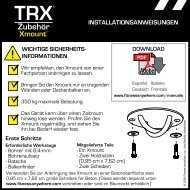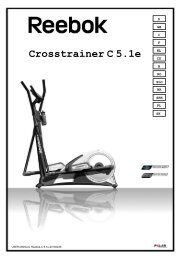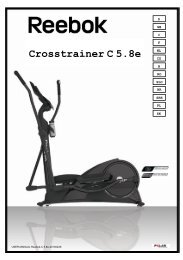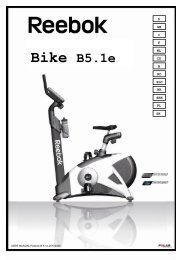by Body-Solid® - Fitness4all
by Body-Solid® - Fitness4all
by Body-Solid® - Fitness4all
You also want an ePaper? Increase the reach of your titles
YUMPU automatically turns print PDFs into web optimized ePapers that Google loves.
PHRASES, TERMS, TIPS<br />
& GUIDELINES<br />
B E G I N N E R ’ S G U I D E L I N E S<br />
• Work out at least two times a week.<br />
• Include six to eight exercises that train major muscle groups.<br />
• Perform two or three sets of at least eight to 12 repetitions.<br />
AEROBIC<br />
Exercise that primarily uses oxygen to burn fuel at low to moderate levels of intensity. Running<br />
and jogging are examples of aerobic exercise.<br />
ANAEROBIC<br />
Exercise that primarily uses the body’s stored fuel for energy. Intense weightlifting is an<br />
example of an anaerobic exercise.<br />
ATROPHY<br />
Decrease of a muscle caused <strong>by</strong> the decrease in the size of its cells because of inactivity.<br />
BALLISTIC STRETCHING<br />
A stretching technique that involves a bouncing or bobbing movement during the stretch. The<br />
final position is not held. This is not a recommended stretching technique.<br />
BREATHING<br />
Never hold your breath during any part of an exercise. Holding your breath may cause severe<br />
intra-thoracic pressure and raise blood pressure leading to dizziness, blackout or other<br />
complications. The rule of thumb is to exhale on exertion and inhale on the return part of the<br />
exercise.<br />
CARDIOVASCULAR<br />
Referring to the heart, lungs, and other periphery systems involved in the transport of oxygen<br />
throughout the body.<br />
CHALLENGE YOUR MUSCLES<br />
All strength training should progress gradually, using increases in weight until your goals are<br />
reached. Then, change your workout to include increased reps or a higher weight resistance.<br />
Alter the order of your exercises, perform multiple sets or different exercises to maintain results<br />
or reach new goals.<br />
CHANGE ROUTINE<br />
Beginner’s please note: If you want to make changes in the exercise routine that you do, wait<br />
until about the six to eight week point. Advanced lifters may want to change routines to avoid<br />
plateus in gaining size or strength.<br />
CIRCUIT TRAINING<br />
Exercise stations that consist of various combinations of weight training, flexibility, calisthenics,<br />
and aerobic exercise.<br />
CONCENTRIC MUSCLE ACTION<br />
The muscle shortens while contracting against resistance.<br />
ECCENTRIC MUSCLE ACTION<br />
The muscle lengthens while contracting against resistance.<br />
EXERCISE FREQUENCY<br />
Exercise each muscle group 2-3 times per week. Allow a minimum of 48 hours rest for each<br />
muscle group worked. If you are doing a total-body workout, three training sessions per week,<br />
performed on every second day, is adequate.<br />
62<br />
EXERCISE LARGE MUSCLES FIRST<br />
You should work your large muscle groups first (ie. squat, bench press, lat pulldown) before<br />
you exercise your small muscle groups (ie. bicep curls, tricep pressdowns, lateral raises).<br />
EXERCISE PROGRAM DURATION<br />
A weight training routine should take anywhere from 45 minutes to one hour to complete. Add<br />
another 20 to 60 minutes when you include stretching, warm-up, aerobics and cool-down.<br />
GIVE YOUR MUSCLES A REST<br />
You’ll get the most out of strength training if you give your muscles at least 48 hours rest to<br />
recover and rebuild between strength training workouts.<br />
HYPERTROPHY<br />
Enlargement of a muscle caused <strong>by</strong> an increase in the size of its cells in response to weight<br />
training.<br />
INTENSITY<br />
The degree to which the body is worked during exercise.<br />
ISOKINETIC EXERCISE<br />
Resistance is given at a fixed velocity of movement with accommodating intensity. A machine<br />
that moves you through an entire range of motion at a preset speed and will not change no<br />
matter how much pressure is put forth <strong>by</strong> the individual.<br />
ISOMETRIC EXERCISE<br />
Contracts the muscle statically without changing its length. Example: Attempting to lift a weight<br />
heavier than you can handle, but cannot move.<br />
ISOTONIC EXERCISE<br />
Shortens and lengthens the muscle through a complete range of motion. This defines weight<br />
training with full range of motion.<br />
MUSCLE FATIGUE<br />
Fatigue is when you can’t possibly do another rep without sacrificing form.<br />
MUSCULAR ENDURANCE<br />
The ability to perform repetitive muscular contractions against some resistance.<br />
MUSCULAR STRENGTH<br />
The maximum force that can be applied <strong>by</strong> a muscle during a single maximum contraction.<br />
OSTEOPOROSIS<br />
A decrease in bone density.<br />
PLYOMETRIC EXERCISE<br />
A technique that includes specific exercises which encompass a rapid stretch of a muscle<br />
eccentrically, followed immediately <strong>by</strong> a rapid concentric contraction of that muscle for the purpose<br />
of facilitating and developing a forceful explosive movement over a short period of time.<br />
Examples of these are using medicine balls for upper extremity and depth jumping for lower<br />
extremeity.










